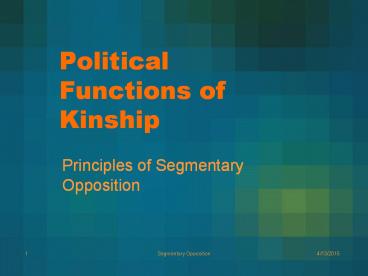Political Functions of Kinship PowerPoint PPT Presentation
1 / 8
Title: Political Functions of Kinship
1
Political Functions of Kinship
- Principles of Segmentary Opposition
2
Kinship institutions are total social facts
- This means not only that they have many
functions, but that kinship groups are the sole
defining principle of social organization. - Descent groups can be divided into very small and
then larger and more inclusive groups. - These are termed
- Minimal lineages the unit above the household,
consists of several households related through
descent. - Maximal lineages can trace exact links of
descent - Clans related, but are so large they cannot
trace exact lines of descent - Phratries agglomeration of clans into two
opposed groups - Tribes combinations of lineages and clans.
- IN Nuerland, they are termed lineages, tertiary
sections, secondary sections and primary
sections.
3
Political Features of the Nuer of southern Sudan
- No centralized government blood feuds are quite
common. - Vengeance is expected by slain kinsmen of the
deceased. - Bloodweath is required of those kinsmen who did
the slaying. - Male children are raised to be courageous in
fighting. - Fights therefore have the potential always to
encompass an entire set of descent groups.
4
Segmentary Opposition Amongst the Nuer
- For each blood feud, the descent group will tend
to combine and support its members. - If the blood feud is between lineages of the same
tertiary section, then these will combine to deal
with the matter, and either fights will ensue or
bloodwealth will be paid and the feud will
subside. - If individuals from different secondary sections
are involved, then the entire set of lineages
within that secondary section will unite. - If individuals from different primary segments
are involved, then the entire set of secondary
sections within that primary section will unite. - Descent and locality are combined hence sections
tend to be associated with villages. - Problem of blood feuds in villages people will
try to avoid them and solve them through the
leopard-skin chief if they occur.
5
(No Transcript)
6
Sections and Tribes
- A tribe is a group within which bloodwealth must
be paid. Cattle raiding generally occurs between
tribes, e.g. the Nuer and the Dinka, but not
within them. - A section is a group that comes into action as a
political entity. - Each segment lineages, sections, or tribes come
into existence in relation to each other and only
under circumstances that warrant it, e.g. a feud
or a cattle raid. - The notion of a tribe is therefore very fuzzy and
relational. - If primary sections in a tribe wars continually,
they will often break up into separate tribes
and one group will move away. - Yet segments also come together and unite to
support each other. - Evans-Pritchard sees this as a system in
equilibrium.
7
(No Transcript)
8
Other examples of segmentary structures
- Swat pathans, in nw pakistan (Barth)
- Political leaders are khans (landowners),
however, the valley was acephalous. Saints are
political mediators. - Land is distributed through each patilineage by
the khan. - Groups of patrilineages form alliances with each
other, resulting in a balanced equilibrium of
competing political blocs.

